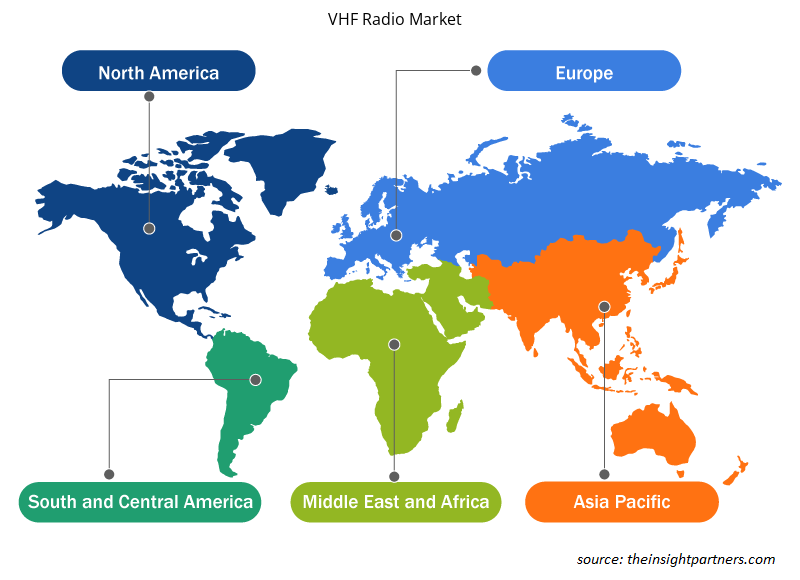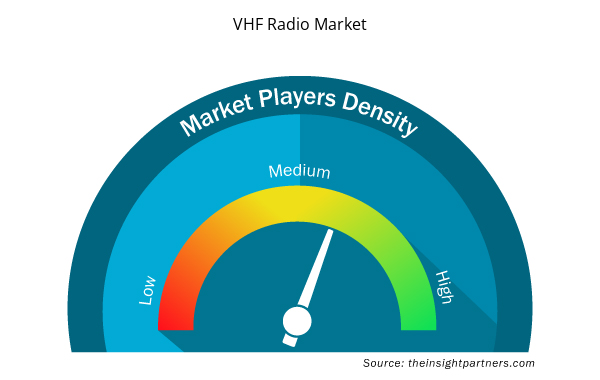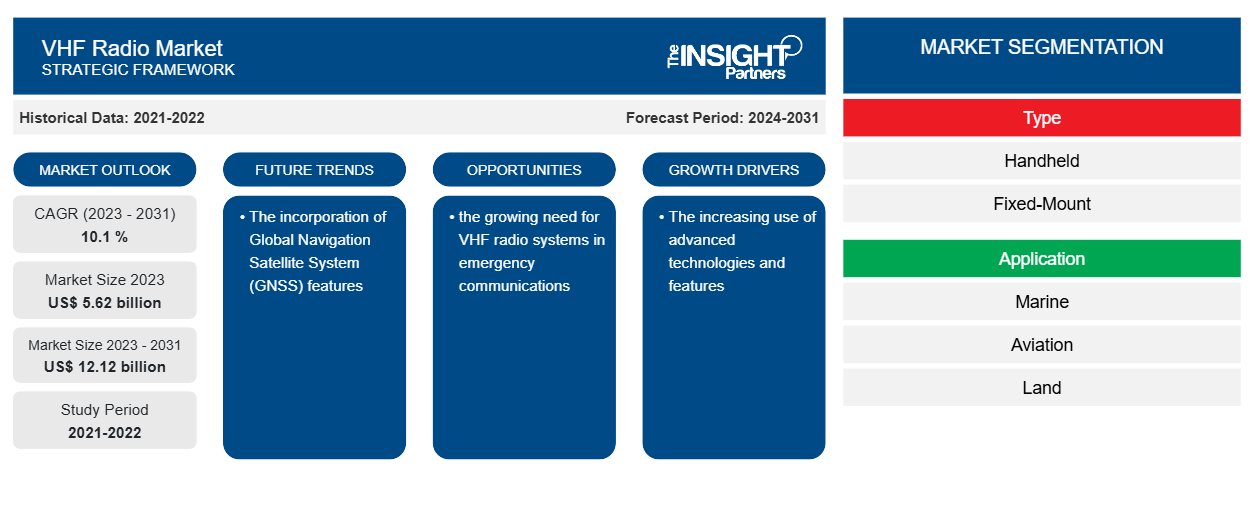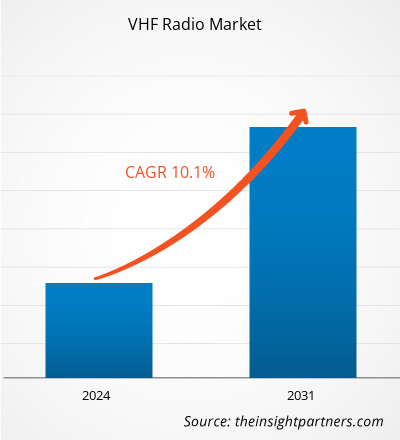Das Marktvolumen für UKW-Radios soll von 5,62 Milliarden US-Dollar im Jahr 2023 auf 12,12 Milliarden US-Dollar im Jahr 2031 anwachsen. Für den Markt wird für den Zeitraum 2023–2031 eine durchschnittliche jährliche Wachstumsrate (CAGR) von 10,1 % erwartet.CAGR of 10.1 % in 2023–2031. Die Einbindung von Funktionen des Globalen Navigationssatellitensystems (GNSS) wird voraussichtlich weiterhin ein wichtiger Trend auf dem UKW-Radiomarkt bleiben.GNSS) features is likely to remain a key VHF radio market trend.
UKW-Radio-Marktanalyse
Der Markt für Hochfrequenzfunkgeräte (VHF) umfasst die Produktion, den Vertrieb und die Nutzung dieser wichtigen Kommunikationsmittel, die in den Bereichen Seefahrt, Luftfahrt, öffentliche Sicherheit und Industrie weit verbreitet sind. VHF-Funkgeräte, die im Frequenzband von 30 bis 300 MHz betrieben werden, ermöglichen stabile und effektive Gespräche von kurzer bis mittlerer Länge. Diese Funkgeräte sind für Echtzeit-Sprachkommunikation, Koordination, Navigation und Notfallmaßnahmen in einer Reihe von Umgebungen von entscheidender Bedeutung. Der Markt unterstützt eine Reihe von Branchen mit speziellen VHF-Funkgeräten, die für spezielle Anforderungen entwickelt wurden, wie z. B. VHF-Seefunkgeräte für die maritime Kommunikation , mobile Landfunkgeräte für die öffentliche Sicherheit und Flugfunkgeräte für die Luftfahrt.
Marktübersicht für UKW-Radio
Der UKW-Funkmarkt wird durch eine breite Produktpalette definiert, darunter Handfunkgeräte, fest installierte Geräte und mobile Funkgeräte, die alle den einzigartigen Kommunikationsanforderungen verschiedener Branchen gerecht werden. Insbesondere in Situationen, in denen keine Fernkommunikation erforderlich ist, sind diese Funkgeräte unverzichtbar, um die Betriebsleistung aufrechtzuerhalten, die Sicherheit zu gewährleisten und gesetzliche Vorschriften einzuhalten. Eines der Hauptmerkmale von UKW-Funkgeräten ist ihre Fähigkeit, verständliche Sprachsignale über große Entfernungen zu übertragen, was sie ideal für Sichtverbindungsszenarien macht.
Passen Sie diesen Bericht Ihren Anforderungen an
Sie erhalten kostenlos individuelle Anpassungen an jedem Bericht, einschließlich Teilen dieses Berichts oder einer Analyse auf Länderebene, eines Excel-Datenpakets sowie tolle Angebote und Rabatte für Start-ups und Universitäten.
- Holen Sie sich die wichtigsten Markttrends aus diesem Bericht.Dieses KOSTENLOSE Beispiel umfasst eine Datenanalyse von Markttrends bis hin zu Schätzungen und Prognosen.
Treiber und Chancen auf dem UKW-Radiomarkt
Wachsender Bedarf an UKW-Funksystemen in der Notfallkommunikation
UKW-Funkgeräte gelten als zuverlässiges Notfallkommunikationsgerät. Regierung, Rettungsdienste und Wohltätigkeitsorganisationen haben Pläne für das Katastrophenmanagement für mögliche Erdbeben- und Hurrikanszenarien. UKW-Funkgeräte sind in solchen Szenarien von entscheidender Bedeutung, um Kontaktlinien zwischen den Rettungskräften herzustellen, wenn die Handysignale gestört sind. Großbritannien ist relativ sicher vor großen Naturkatastrophen in Europa wie Hurrikanen und Erdbeben, aber durch Überschwemmungen bedingte zivile Notfälle werden immer häufiger und gefährlicher für das Leben der Menschen. Daher nutzt das Land selbst im schlimmsten Fall UKW-Funkgeräte in großem Umfang für eine verbesserte Kommunikation, um eine solche Katastrophe bewältigen zu können. Unternehmen konzentrieren sich stark auf die Entwicklung effektiver UKW-Funksysteme, um Notfälle bewältigen zu können. Das in Großbritannien ansässige Unternehmen DCS 2-Way Radio Ltd. beispielsweise stellt UKW-Funkgeräte her, um Krankenhäuser und Rettungsdienste zu unterstützen.DCS 2-Way Radio Ltd. creates VHF radios to help hospitals and emergency services.
Zunehmende Nutzung fortschrittlicher Technologien und Funktionen
VHF-Radios werden mit modernen Funktionen und Technologien ausgestattet, um sie zu anspruchsvolleren Kommunikationsinstrumenten mit besserer Funktionalität, Leistung und Benutzerfreundlichkeit zu machen. Eine dieser Weiterentwicklungen sind digitale Signalverarbeitungsprozessoren (DSP), die für eine verbesserte Spektrumeffizienz, Rauschunterdrückung und Audioqualität sorgen. VHF-Radios verfügen außerdem über hochmoderne Funktionen wie Dualband-Betrieb, GPS-Navigation und Bluetooth-Konnektivität, um ihre Nützlichkeit und Benutzerfreundlichkeit weiter zu verbessern. Daher wird erwartet, dass die zunehmende Nutzung fortschrittlicher Technologien und Funktionen den Akteuren auf dem VHF-Radiomarkt im Prognosezeitraum neue Möglichkeiten eröffnen wird.
Segmentierungsanalyse des UKW-Radiomarktberichts
Wichtige Segmente, die zur Ableitung der UKW-Radiomarktanalyse beigetragen haben, sind Typ und Anwendung.
- Basierend auf dem Typ ist der UKW-Funkmarkt in Handfunkgeräte und Festgeräte unterteilt. Das Handfunkgerätesegment hatte im Jahr 2023 einen größeren Marktanteil.
- Nach Anwendung ist der Markt in die Bereiche Schifffahrt, Luftfahrt und Land unterteilt.
Marktanteilsanalyse für UKW-Radios nach geografischer Lage
Der geografische Umfang des VHF-Radiomarktberichts ist hauptsächlich in fünf Regionen unterteilt: Nordamerika, Asien-Pazifik, Europa, Naher Osten und Afrika sowie Südamerika/Süd- und Mittelamerika. In Bezug auf den Umsatz hatte Nordamerika den größten Marktanteil im VHF-Radiomarkt. Die USA verfügen derzeit über eine robuste Hafeninfrastruktur und Schifffahrtsindustrie, was auf ihre starke Abhängigkeit von Importen und die erhebliche Auslagerung von Fertigungs- und Produktionsanlagen in andere Volkswirtschaften zurückzuführen ist. Aus diesem Grund ist das Land derzeit für einen reibungslosen Betrieb, die Instandhaltung und die Expansion der Industrie auf eine breite Palette von Produkten im Zusammenhang mit der Schifffahrtsindustrie angewiesen.
Regionale Einblicke in den UKW-Radiomarkt
Die regionalen Trends und Faktoren, die den UKW-Radiomarkt im Prognosezeitraum beeinflussen, wurden von den Analysten von Insight Partners ausführlich erläutert. In diesem Abschnitt werden auch die Marktsegmente und die Geografie des UKW-Radiomarkts in Nordamerika, Europa, im asiatisch-pazifischen Raum, im Nahen Osten und Afrika sowie in Süd- und Mittelamerika erörtert.

- Erhalten Sie regionalspezifische Daten zum UKW-Radiomarkt
Umfang des UKW-Radio-Marktberichts
| Berichtsattribut | Details |
|---|---|
| Marktgröße im Jahr 2023 | 5,62 Milliarden US-Dollar |
| Marktgröße bis 2031 | 12,12 Milliarden US-Dollar |
| Globale CAGR (2023 - 2031) | 10,1 % |
| Historische Daten | 2021-2022 |
| Prognosezeitraum | 2024–2031 |
| Abgedeckte Segmente | Nach Typ
|
| Abgedeckte Regionen und Länder | Nordamerika
|
| Marktführer und wichtige Unternehmensprofile |
|
Marktteilnehmerdichte: Der Einfluss auf die Geschäftsdynamik
Der Markt für UKW-Radios wächst rasant. Die Nachfrage der Endnutzer steigt aufgrund von Faktoren wie sich entwickelnden Verbraucherpräferenzen, technologischen Fortschritten und einem größeren Bewusstsein für die Vorteile des Produkts. Mit der steigenden Nachfrage erweitern Unternehmen ihr Angebot, entwickeln Innovationen, um die Bedürfnisse der Verbraucher zu erfüllen, und nutzen neue Trends, was das Marktwachstum weiter ankurbelt.
Die Marktteilnehmerdichte bezieht sich auf die Verteilung der Firmen oder Unternehmen, die in einem bestimmten Markt oder einer bestimmten Branche tätig sind. Sie gibt an, wie viele Wettbewerber (Marktteilnehmer) in einem bestimmten Marktraum im Verhältnis zu seiner Größe oder seinem gesamten Marktwert präsent sind.
Die wichtigsten auf dem UKW-Radiomarkt tätigen Unternehmen sind:
- Kobra
- Entel UK Limited
- Icom Inc.
- Jotron
- Abonnieren
- Navico-Gruppe
Haftungsausschluss : Die oben aufgeführten Unternehmen sind nicht in einer bestimmten Reihenfolge aufgeführt.

- Überblick über die wichtigsten Akteure auf dem UKW-Radiomarkt
Neuigkeiten und aktuelle Entwicklungen zum UKW-Radiomarkt
Der UKW-Radiomarkt wird durch die Erhebung qualitativer und quantitativer Daten nach Primär- und Sekundärforschung bewertet, die wichtige Unternehmensveröffentlichungen, Verbandsdaten und Datenbanken umfasst. Im Folgenden finden Sie eine Liste der Entwicklungen auf dem Markt für Sprach- und Sprechstörungen sowie Strategien:
- Im November 2023 stellte Icom mit dem weltweit ersten Marine-VHF/LTE-Hybridradio, dem IP-M60, eine bedeutende Innovation in der Funkkommunikation vor. Dieses revolutionäre Gerät, das offiziell auf der METS 2023 (Marine Equipment Trade Show) vorgestellt wurde, kombiniert nahtlos die Fähigkeiten eines LTE-Radios mit der Zuverlässigkeit eines Marine-VHF-Radios in einem einzigen Handgerät. (Quelle: Icom, Pressemitteilung)
- Im März 2024 kündigte Aireon, der führende Anbieter von weltraumgestützten Datenprodukten und -diensten für das Flugverkehrsmanagement, an, mit der Gründung der Aireon Space-Based VHF Coalition, einer Gruppe von Organisationen, die das Betriebskonzept für weltraumgestützte VHF-Sprach- und Datenkommunikation für die Luftfahrt entwickeln wird, die nächste große Entwicklung in puncto Sicherheit und Effizienz anzuführen. (Quelle: Aireon, Pressemitteilung)
Marktbericht zum UKW-Radio – Abdeckung und Ergebnisse
Der Bericht „Marktgröße und Prognose für UKW-Radios (2021–2031)“ bietet eine detaillierte Analyse des Marktes, die die folgenden Bereiche abdeckt:
- Marktgröße und Prognose auf globaler, regionaler und Länderebene für alle wichtigen Marktsegmente, die im Rahmen des Projekts abgedeckt sind
- Marktdynamik wie Treiber, Beschränkungen und wichtige Chancen
- Wichtige Zukunftstrends
- Detaillierte PEST/Porters Five Forces- und SWOT-Analyse
- Globale und regionale Marktanalyse mit wichtigen Markttrends, wichtigen Akteuren, Vorschriften und aktuellen Marktentwicklungen
- Branchenlandschaft und Wettbewerbsanalyse, einschließlich Marktkonzentration, Heatmap-Analyse, prominenten Akteuren und aktuellen Entwicklungen
- Detaillierte Firmenprofile
- Historische Analyse (2 Jahre), Basisjahr, Prognose (7 Jahre) mit CAGR
- PEST- und SWOT-Analyse
- Marktgröße Wert/Volumen – Global, Regional, Land
- Branche und Wettbewerbsumfeld
- Excel-Datensatz



Report Coverage
Revenue forecast, Company Analysis, Industry landscape, Growth factors, and Trends

Segment Covered
This text is related
to segments covered.

Regional Scope
North America, Europe, Asia Pacific, Middle East & Africa, South & Central America

Country Scope
This text is related
to country scope.
Häufig gestellte Fragen
The global VHF radio market was estimated to be US$ 5.62 billion in 2023 and is expected to grow at a CAGR of 10.1 % during the forecast period 2023 - 2031.
The increasing use of advanced technologies and features and the growing need for VHF radio systems in emergency communications are the major factors that propel the global VHF radio market.
The incorporation of Global Navigation Satellite System (GNSS) features is anticipated to play a significant role in the global VHF radio market in the coming years.
The key players holding majority shares in the global VHF radio market are Cobra, Entel UK Limited, Icom Inc., Jotron, and JVCKENWOOD.
The global VHF radio market is expected to reach US$ 12.12 billion by 2031.
Trends and growth analysis reports related to Electronics and Semiconductor : READ MORE..
The Insight Partners performs research in 4 major stages: Data Collection & Secondary Research, Primary Research, Data Analysis and Data Triangulation & Final Review.
- Data Collection and Secondary Research:
As a market research and consulting firm operating from a decade, we have published and advised several client across the globe. First step for any study will start with an assessment of currently available data and insights from existing reports. Further, historical and current market information is collected from Investor Presentations, Annual Reports, SEC Filings, etc., and other information related to company’s performance and market positioning are gathered from Paid Databases (Factiva, Hoovers, and Reuters) and various other publications available in public domain.
Several associations trade associates, technical forums, institutes, societies and organization are accessed to gain technical as well as market related insights through their publications such as research papers, blogs and press releases related to the studies are referred to get cues about the market. Further, white papers, journals, magazines, and other news articles published in last 3 years are scrutinized and analyzed to understand the current market trends.
- Primary Research:
The primarily interview analysis comprise of data obtained from industry participants interview and answers to survey questions gathered by in-house primary team.
For primary research, interviews are conducted with industry experts/CEOs/Marketing Managers/VPs/Subject Matter Experts from both demand and supply side to get a 360-degree view of the market. The primary team conducts several interviews based on the complexity of the markets to understand the various market trends and dynamics which makes research more credible and precise.
A typical research interview fulfils the following functions:
- Provides first-hand information on the market size, market trends, growth trends, competitive landscape, and outlook
- Validates and strengthens in-house secondary research findings
- Develops the analysis team’s expertise and market understanding
Primary research involves email interactions and telephone interviews for each market, category, segment, and sub-segment across geographies. The participants who typically take part in such a process include, but are not limited to:
- Industry participants: VPs, business development managers, market intelligence managers and national sales managers
- Outside experts: Valuation experts, research analysts and key opinion leaders specializing in the electronics and semiconductor industry.
Below is the breakup of our primary respondents by company, designation, and region:

Once we receive the confirmation from primary research sources or primary respondents, we finalize the base year market estimation and forecast the data as per the macroeconomic and microeconomic factors assessed during data collection.
- Data Analysis:
Once data is validated through both secondary as well as primary respondents, we finalize the market estimations by hypothesis formulation and factor analysis at regional and country level.
- Macro-Economic Factor Analysis:
We analyse macroeconomic indicators such the gross domestic product (GDP), increase in the demand for goods and services across industries, technological advancement, regional economic growth, governmental policies, the influence of COVID-19, PEST analysis, and other aspects. This analysis aids in setting benchmarks for various nations/regions and approximating market splits. Additionally, the general trend of the aforementioned components aid in determining the market's development possibilities.
- Country Level Data:
Various factors that are especially aligned to the country are taken into account to determine the market size for a certain area and country, including the presence of vendors, such as headquarters and offices, the country's GDP, demand patterns, and industry growth. To comprehend the market dynamics for the nation, a number of growth variables, inhibitors, application areas, and current market trends are researched. The aforementioned elements aid in determining the country's overall market's growth potential.
- Company Profile:
The “Table of Contents” is formulated by listing and analyzing more than 25 - 30 companies operating in the market ecosystem across geographies. However, we profile only 10 companies as a standard practice in our syndicate reports. These 10 companies comprise leading, emerging, and regional players. Nonetheless, our analysis is not restricted to the 10 listed companies, we also analyze other companies present in the market to develop a holistic view and understand the prevailing trends. The “Company Profiles” section in the report covers key facts, business description, products & services, financial information, SWOT analysis, and key developments. The financial information presented is extracted from the annual reports and official documents of the publicly listed companies. Upon collecting the information for the sections of respective companies, we verify them via various primary sources and then compile the data in respective company profiles. The company level information helps us in deriving the base number as well as in forecasting the market size.
- Developing Base Number:
Aggregation of sales statistics (2020-2022) and macro-economic factor, and other secondary and primary research insights are utilized to arrive at base number and related market shares for 2022. The data gaps are identified in this step and relevant market data is analyzed, collected from paid primary interviews or databases. On finalizing the base year market size, forecasts are developed on the basis of macro-economic, industry and market growth factors and company level analysis.
- Data Triangulation and Final Review:
The market findings and base year market size calculations are validated from supply as well as demand side. Demand side validations are based on macro-economic factor analysis and benchmarks for respective regions and countries. In case of supply side validations, revenues of major companies are estimated (in case not available) based on industry benchmark, approximate number of employees, product portfolio, and primary interviews revenues are gathered. Further revenue from target product/service segment is assessed to avoid overshooting of market statistics. In case of heavy deviations between supply and demand side values, all thes steps are repeated to achieve synchronization.
We follow an iterative model, wherein we share our research findings with Subject Matter Experts (SME’s) and Key Opinion Leaders (KOLs) until consensus view of the market is not formulated – this model negates any drastic deviation in the opinions of experts. Only validated and universally acceptable research findings are quoted in our reports.
We have important check points that we use to validate our research findings – which we call – data triangulation, where we validate the information, we generate from secondary sources with primary interviews and then we re-validate with our internal data bases and Subject matter experts. This comprehensive model enables us to deliver high quality, reliable data in shortest possible time.


 Holen Sie sich ein kostenloses Muster für diesen Bericht
Holen Sie sich ein kostenloses Muster für diesen Bericht